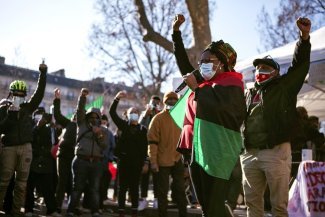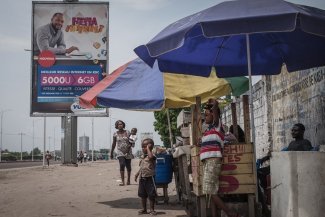
On Atlantic City’s seaside promenade bordering the Atlantic Ocean, war veteran Leslie Lee sells small American flags in the shadow of an abandoned casino: the Trump Plaza Hotel. Leslie is in a wheelchair, “because of basketball, which wrecked my knees, not the war,” he clarifies.
Leslie celebrated his 20th birthday in Da Nang, Vietnam, to where he was conscripted to fight, like thousands of other men from his generation. Apart from his year of birth – 1946 – he has almost nothing in common with Donald Trump, the Republican Party’s candidate in the presidential election. The billionaire managed to avoid the draft thanks to several letters from Wharton Business School, where he was a student, deferring his conscription and finally declaring him medically unfit to serve, claiming he had a deformity in his foot.
Trump is white and rich. Leslie is Black and has a pension of around US$1000 per month. With this level of income, he is considered poor in the United States.
What does he expect the candidates will do to help people in his situation? Not much and, surprisingly, even less from Hillary Clinton than from Donald Trump. “The Clinton’s are in the pockets of the lobbyists. They get money from the financial institutions to write speeches. The whole system is rotten to the core,” says Leslie. He is interested in Trump “because he is not a politician”, “he cannot be bought”, “he created a lot of jobs in Atlantic City in earlier years” and “he’s clever with his money.”
It’s a familiar tune: the United States is the most unequal country in the western world, with 13.5 per cent of its population living below the poverty line, according to the latest report from the US Census Bureau. This amounted to just over 43 million people in 2015.
Although this figure is a small improvement on the previous year, it is still very high for an industrialised country. And neither Hillary Clinton nor Donald Trump has made the fight against this embarrassing statistic a priority.
Their speeches, which focus almost entirely on promises of job creation, say almost nothing about helping the unemployed or the working poor, or tackling other issues in the country that make the lives of poor people particularly difficult, such as access to housing and credit.
The US Census Bureau sets the poverty line according to an individual’s income and family situation: for a couple with two children, for example, it is set at US$24,036 per year.
Its latest statistics are positive however on the economic recovery and the rise in living standards. They are the best figures since the 2007 recession.
Average household income rose by 5.2 per cent between 2014 and 2015, and it is the first time since 1999 that the three indicators of poverty, health cover and salaries have risen together.
But this recovery has passed poor Americans by. The Gini index – the tool used to calculate income inequality across a country – has risen over the years. It has increased 5.5 per cent since the first measurement was made in 1993.
The biggest problem – housing
The candidates have not given “a full-voiced condemnation of the level or extent of poverty in America today,” says Matthew Desmond, a Harvard professor of sociology in an article for the New York Times. “We aren’t having in our presidential debate right now a serious conversation about the fact that we are the richest democracy in the world, with the most poverty. It should be at the very top of the agenda.”
Desmond believes the rise in the hourly minimum wage from US$7.5 to US$12 promised by Hillary Clinton will not be enough to fix this severe problem.
In his work, Desmond focuses on a problem specific to the United States that is rife in poor neighbourhoods: home evictions. He has written a book about it, Evicted, in which he describes the spiral of dangerously high interest loans which are the only borrowing option available, the lack of affordable housing and the mounting proportion of their budget that poor families have to spend on housing.
Millions of American families struggling to make ends meet live in constant fear of eviction. Atlantic County is exceptionally bad: in 2015 it had the highest foreclosure rate in the United States.
As Desmond explains in his article, last century evictions were extremely rare and led to impressive demonstrations of support from the rest of the neighbourhood.
Today there are sheriff squads whose full-time job is to carry out evictions and foreclosure orders.
It has created a burgeoning economy of removal companies specialising in evictions and law firms that hunt for any record of bankruptcy in a tenant’s past to push up the interest on a loan.
“Fewer and fewer families can afford a roof over their head,” continues Desmond. “For decades we’ve focused mainly on jobs, public assistance, parenting, and mass incarceration. None can deny the importance of these issues but something fundamental is missing. We have failed to fully appreciate how deeply housing is implicated in the creation of poverty.”
A two-tier country
Another big problem is the economic imbalance between regions. The country is splitting in two economically with, broadly speaking, the coastal regions and attractive major towns that are productive and are reaping the fruits of growth; and the rural areas, the Midwest, the Appalachians, that have not recovered since the recession and are collapsing economically and structurally.
The consumption of heroin and anti-depressants has become a major public health issue in several states. It is one issue on which Trump scores winning points.
It is difficult to talk about Donald Trump’s plans to help the poor, because the business man communicates in slogans: in mid-September at a meeting in the Waldorf-Astoria Hotel in New York, he promised to create 25 million jobs, but without explaining how.
And in July he said he would raise the minimum wage to US$10, but he has contradicted himself several times since then. In his last speech on the economy in Detroit he didn’t even mention it. It is clear however that while Trump’s speeches are designed to appeal to the middle class, his tax cutting programme, insofar as he has revealed it, will benefit the richest Americans.
Hillary Clinton, on the other hand, has a very detailed and fiscally highly complex programme. She is focusing on the middle class in the hope that support for them will also benefit the very poor. She wants to increase social assistance for health insurance, child care and education.
While Heather Boushey, Executive Director of the Washington Center for Equitable Growth, a Washington-based NGO told New York Times that “Hillary Clinton is running on the most progressive platform any party has put together,” many on the left think that Clinton should address the problem of poverty in the country more clearly and directly.
Leslie says he will not be voting, because he “doesn’t believe in bipartism any more”.








